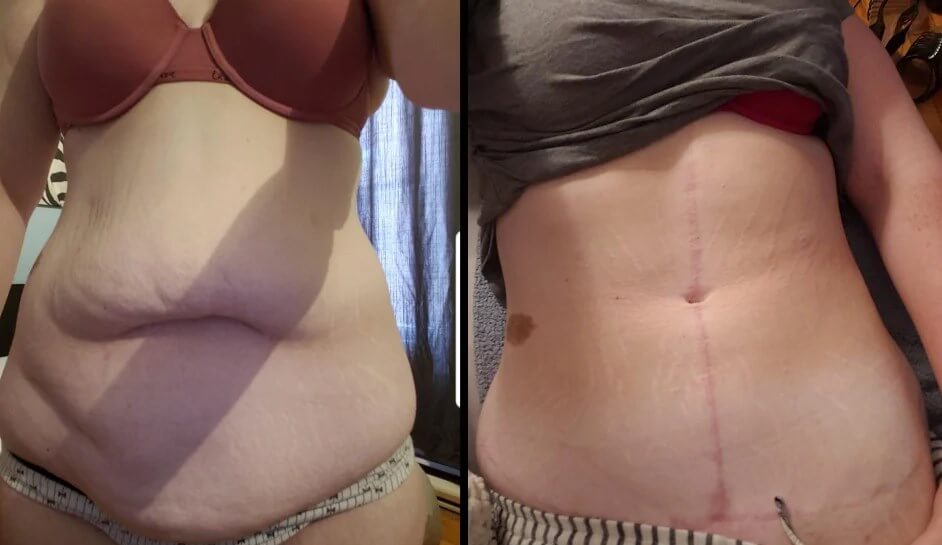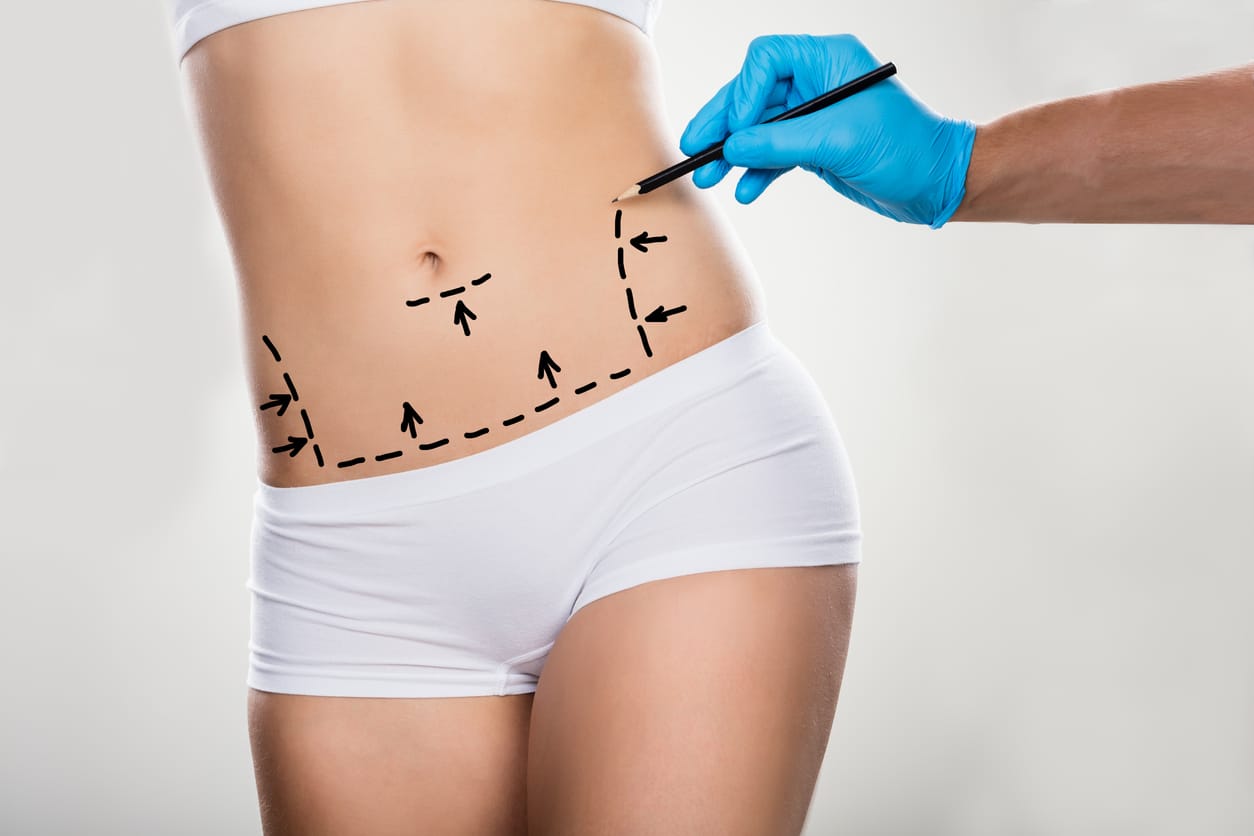If you’re considering getting a tummy tuck but don’t know all the details, this article is for you. We’ll discuss what tummy tuck surgery entails, from muscle repair to permanent stitches used to tighten the area. Read on to learn more about this procedure and how it could benefit you!
Table of Contents
What is a Tummy Tuck?
A tummy tuck, also called an abdominoplasty, is a cosmetic surgery procedure used to improve the appearance of the abdomen. The surgery involves removing excess skin and fat from the stomach area and tightening the abdominal muscles.
Most people who undergo a tummy tuck are unhappy with their current appearance due to excess skin and/or fat in the stomach area that has not responded to diet or exercise. Some people may also have loose or saggy skin in the stomach area due to weight loss or pregnancy. A tummy tuck can help to improve the appearance of the stomach by making it look tighter and more toned.
The surgery is usually performed under general anesthesia and takes about two hours to complete. During the surgery, the surgeon will make an incision in the lower abdomen, just above the pubic area. The incision will be about 6-10 inches long, depending on how much skin needs to be removed. The surgeon will then separate the skin from the underlying abdominal muscles and remove any excess fat using liposuction. Once all of the excess tissue has been removed, the surgeon will then tighten the abdominal muscles before closing up the incisions with stitches.
After your surgery, you can expect to spend one night in the hospital before being released home. You will need someone to drive you home as you will not be able to drive yourself after having general anesthesia. Recovery from a tummy tuck usually takes about four weeks total. During
How Does it Work?
When you opt for a tummy tuck, also called an abdominoplasty, your cosmetic surgeon will make an incision in the lower abdomen. The length and location of your incision will depend on how much excess skin and fat needs to be removed. Once the incision is made, your surgeon will separate the skin from the abdominal muscles and may remove some of the underlying fat.
Next, your surgeon will tighten the abdominal muscles and stitch them into their new position. This step is especially important if you have diastasis recti, which is a condition that causes separation of the abdominal muscles. Once the muscles are repaired, any excess skin will be removed and the remaining skin will be pulled down and stitched together. You will likely have drains placed under your skin to help remove excess fluid as you heal.
Does Tummy Tuck Involve Muscle Repair?
A tummy tuck, also known as an abdominoplasty, is a surgical procedure that removes excess skin and fat from the lower abdomen. It can also tighten abdominal muscles that have been stretched or weakened by pregnancy or weight gain.
Most commonly, a tummy tuck involves muscle repair. The surgeon will make an incision in the lower abdomen, just above the pubic bone. Through this incision, they will access the underlying muscle layer and determine if any repair is necessary.
If muscle repair is needed, the surgeon will suture the muscles back together. This will help to create a more firm and toned appearance to the abdomen. In some cases, a mesh may be used to support the repaired muscles.

Via Reddit
After any repairs are made, the excess skin and fat will be removed. The incisions will then be closed with stitches or staples. A drainage tube may also be placed under the skin to help drain any excess fluid that may accumulate.
The surgery typically takes two to three hours to complete, but this will depend on the extent of work being done. Most people stay in the hospital for one to two nights after their surgery before being discharged home. Recovery times vary depending on the individual, but are typically around four to six weeks before resuming normal activities.
Types of Abdominoplasty Procedures
There are four types of abdominoplasty procedures: full, mini, extended, and circumferential.
Full abdominoplasty is the most common type of procedure. It involves making an incision from hip to hip, as well as a smaller incision around the navel. The skin is then lifted off the abdominal wall so that the underlying muscles can be tightened with sutures. Excess skin is removed and the incisions are closed with sutures or staples.
Mini abdominoplasty is similar to full abdominoplasty, but the incisions are smaller. This type of procedure is often used for patients who have a small amount of excess skin and fat around the belly button.
Extended abdominoplasty is used for patients who have excess skin and fat extending down onto the thighs or buttocks. This type of procedure involves making an incision from hip to hip, as well as a smaller incision around the navel. The skin is then lifted off the abdominal wall and thigh area so that the underlying muscles can be tightened with sutures. Excess skin and fat are removed from both the abdomen and thigh area, and the incisions are closed with sutures or staples.
Circumferential abdominoplasty (also known as a “belt lipectomy”) is used for patients who have excess skin and fat around their entire midsection, including their backside. This type
Benefits of a Tummy Tuck
A tummy tuck, also known as abdominoplasty, is a cosmetic surgery procedure that removes excess skin and fat from the abdomen and tightens the abdominal muscles.
There are many benefits of a tummy tuck, including:
1. Improved Appearance: A tummy tuck can give you a flatter, more toned appearance by removing excess skin and fat and tightening the abdominal muscles.
2. Increased Confidence: Many people who have a tummy tuck experience an increase in confidence due to their improved appearance.
3. Enhanced self-image: Achieving your desired look can lead to an enhancement in your self-image and overall quality of life.
4. Relief from back pain: Carrying excess weight in your stomach can cause back pain. Losing this weight can help to alleviate this pain.
Risks Associated with a Tummy Tuck
There are certain risks associated with any surgical procedure, and a tummy tuck is no different. These risks include infection, bleeding, and reactions to anesthesia. Additionally, there is a risk of damage to the nerves or blood vessels in the area being operated on.
While the vast majority of patients who undergo a tummy tuck experience no complications, it’s important to be aware of the potential risks before making the decision to undergo surgery. If you have any questions or concerns about the risks involved in a tummy tuck, be sure to discuss them with your plastic surgeon prior to scheduling your procedure.
Preparation for a Tummy Tuck
Preparation for a Tummy Tuck
Most people who elect to have a tummy tuck are self-conscious about the excess skin and fat around their midsection. In some cases, diet and exercise alone cannot achieve the desired results. A tummy tuck can give you a flatter, more toned stomach by removing excess skin and fat and tightening the abdominal muscles.
If you are considering a tummy tuck, it is important to be at a stable weight and to have realistic expectations about the procedure and its results. You should also be in good general health and free from any conditions that could complicate surgery or healing.
Your surgeon will likely recommend that you lose any excess weight prior to surgery, as this will make the procedure easier and decrease your risk of complications. If you are a smoker, you will need to quit at least six weeks before surgery, as smoking can impede healing. You should also avoid taking any medications or supplements that could thin your blood or increase bleeding during surgery.
Prior to your procedure, your surgeon will thoroughly evaluate your health and medical history to ensure that you are an appropriate candidate for surgery. They will also take measurements of your abdomen and take photographs for your medical records. Once everything is been reviewed and approved, you will be given specific instructions on how to prepare for surgery, including fasting for a certain period of time before the procedure.
Recovery from a Tummy Tuck
Most people who undergo a tummy tuck procedure experience little to no pain and are able to return home the same day. Recovery times vary from individual to individual, but are typically pretty short. It is important to take it easy for the first few days following your surgery, but most people are able to return to their normal activities within a week or two.
If you have experienced significant weight loss or have had multiple pregnancies, your recovery may take longer as your skin and muscles will need time to adjust and heal properly. Your surgeon will provide you with specific instructions on how to care for your incisions and what activities you should avoid during your recovery period. Following these instructions closely will help ensure a smooth and successful recovery.
Alternatives to a Tummy Tuck
If you are considering a tummy tuck but are worried about the muscle repair involved, there are some alternatives that may be right for you. Liposuction is one option that can help to contour the stomach without the need for muscle repair. Another option is a mini tummy tuck, which involves a smaller incision and less manipulation of the muscles.
It’s important to consult with a board-certified plastic surgeon to discuss all of your options and find out which procedure will best help you achieve your desired results.
Conclusion
In conclusion, a tummy tuck can involve muscle repair but it doesn’t always. It depends on the individual and their goals as to whether or not they will opt for muscle repair during the procedure. If you think you may benefit from a tummy tuck, make sure to consult with your plastic surgeon to discuss all of your options and determine what is best suited for your body type and desired outcome.




